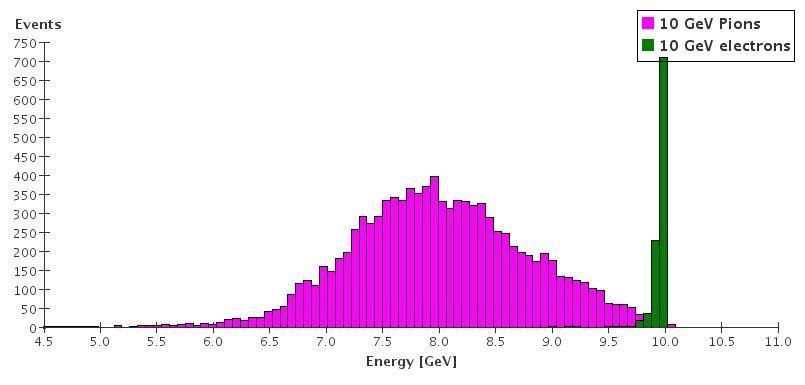...
Principle of a dual read out calorimeter
The response of a calorimeter is very different for e+, e- and photons compared to hadrons. For e+, e- and photons the total energy of the incoming particle is converted into detectable kinetic energy of electrons leading to excellent energy resolution for electrons/photons. Hadrons on the other hand break nuclei and liberate nucleons/nuclear fragments. Even if the kinetic energy of the resulting nucleons is measured, the significant fraction of energy is lost to overcome the binding energy. Fluctuations of the number of broken nuclei dominate fluctuations of the observed energy leading to a relatively poor energy resolution for hadrons.This is demonstrated in the figure below where the ionization loss of a 10 GeV Pion is compared with the ionization loss of a 10 GeV electron. In both cases we use a simple Iron block as an absorber that contains the entire shower.
...
Eem/Etot ~ ECherenkov/Eionization
'EM' shower => Relativistic electrons => Lots of Cherenkov light
Hadronic shower => Most particles below the Cherenkov threshold
Use this fact to correct hadron response
Novel calorimeter concepts under consideration for future lepton collider experiments are aimed to achieve high energy resolution for single hadrons and for hadronic jets. The energy resolution improvement is achieved by reading out two different signal components: Szintilation light which is proportional to the energy deposited via ionization and Cerenkov light which is used as an estimator of the energy loss due to nuclear processes. The cerenkov signal can be used to correct the energy deposit as measured by the szintilation signal.
Reconstruction of jet-jet invariant mass in a segmented total absorption dual read out calorimeter is investigated in a specific example of the crystal-based calorimeter for the SiD detector. The detector geometry is defined and the detector simulation is carried out within the geant 4 based SLIC (Simulation for LInear Collider) framework.
The analysis programs are developed in JAVA within the JAS3 (Java Analys Studio)
environment.
Correlation between the total observed ionization energy and the electromagnetic component of the shower, as measured by the Cherenkov component. The calibration factor K is determined by the requirement that K×ECherenkov = Eionization for electrons.
...
Material | Density | Radiation length | Interaction length | ||
|---|---|---|---|---|---|
<ac:structured-macro ac:name="unmigrated-wiki-markup" ac:schema-version="1" ac:macro-id="4f792846d34e270b-c2c80125-483c42b1-900a8801-2c27953b8457bd4188f5ae2a"><ac:plain-text-body><![CDATA[ |
| [g/cm3] | [cm] | [cm] | ]]></ac:plain-text-body></ac:structured-macro> |
BGO | 7.13 | 1.12 | 21.88 | ||
PbWO4 | 8.3 | 0.9 | 18. | ||
SCG1-C | 3.36 | 4.25 | 45.6 |
|
|
|
| BGO |
| PbWO4 |
| ||
|---|---|---|---|---|---|---|---|---|---|
Detector | Layers | Thickness/layer | Segmentation | X0 | Lambda | X0 | Lambda | ||
<ac:structured-macro ac:name="unmigrated-wiki-markup" ac:schema-version="1" ac:macro-id="448fc1b8cfb48c58-6a8a232b-4fa64fc8-8b538d6d-b617b02b89f6f4d831dd7be7"><ac:plain-text-body><![CDATA[ |
|
| [cm] | [cmxcm] |
|
|
|
| ]]></ac:plain-text-body></ac:structured-macro> |
ECAL Barrel | 8 | 3 | 3x3 | 21.4 | 1.1 | 27 | 1.3 | ||
HCAL Barrel | 17 | 6 | 6x6 |
| 4.7 |
| 5.7 | ||
Total Barrel | 25 |
|
|
| 5.8 |
| 7 | ||
|
|
|
|
|
|
|
| ||
ECAL EndCAP | 8 | 3 | 3x3 | 21.4 | 1.1 | 27 | 1.3 | ||
HCAL EndCAP | 17 | 6 | 6x6 |
| 4.7 |
| 5.7 | ||
Total EndCAP | 25 |
|
|
| 5.8 |
| 7 |
...
